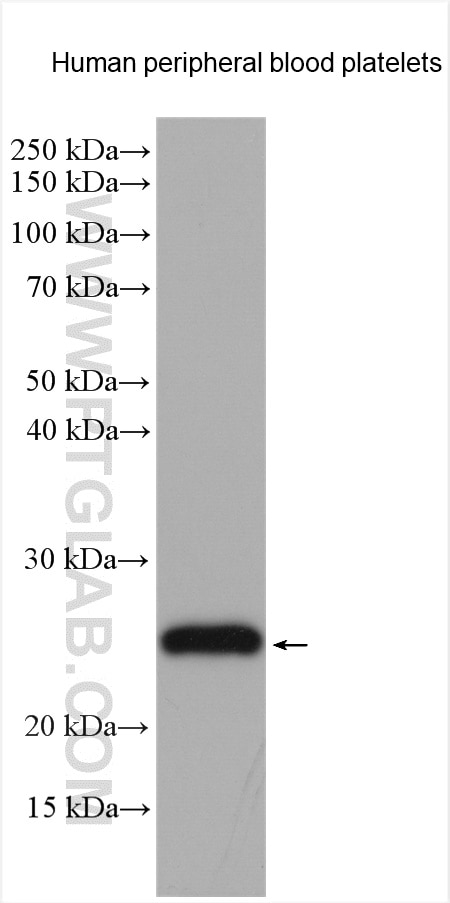CD42c Polyklonaler Antikörper
CD42c Polyklonal Antikörper für WB, ELISA
Wirt / Isotyp
Kaninchen / IgG
Getestete Reaktivität
human
Anwendung
WB, ELISA
Konjugation
Unkonjugiert
Kat-Nr. : 55161-1-AP
Synonyme
Geprüfte Anwendungen
| Erfolgreiche Detektion in WB | Human peripheral blood platelets |
Empfohlene Verdünnung
| Anwendung | Verdünnung |
|---|---|
| Western Blot (WB) | WB : 1:1000-1:8000 |
| It is recommended that this reagent should be titrated in each testing system to obtain optimal results. | |
| Sample-dependent, check data in validation data gallery | |
Produktinformation
55161-1-AP bindet in WB, ELISA CD42c und zeigt Reaktivität mit human
| Getestete Reaktivität | human |
| Wirt / Isotyp | Kaninchen / IgG |
| Klonalität | Polyklonal |
| Typ | Antikörper |
| Immunogen | Peptid |
| Vollständiger Name | glycoprotein Ib (platelet), beta polypeptide |
| Berechnetes Molekulargewicht | 43 kDa |
| Beobachtetes Molekulargewicht | 26 kDa |
| GenBank-Zugangsnummer | NM_000407 |
| Gene symbol | CD42c |
| Gene ID (NCBI) | 2812 |
| Konjugation | Unkonjugiert |
| Form | Liquid |
| Reinigungsmethode | Antigen-Affinitätsreinigung |
| Lagerungspuffer | PBS with 0.02% sodium azide and 50% glycerol |
| Lagerungsbedingungen | Bei -20°C lagern. Nach dem Versand ein Jahr lang stabil Aliquotieren ist bei -20oC Lagerung nicht notwendig. 20ul Größen enthalten 0,1% BSA. |
Hintergrundinformationen
CD42c, also known as platelet glycoprotein Ib beta chain (GP1BB), is a transmembrane protein containing a leucine-rich amino acid sequence (PMID: 3353370). CD42c is covalently linked to platelet glycoprotein Ib alpha chain (CD42b/GP1BA) to form GPIb, which is part of the Glycoprotein Ib-V-IX receptor (GPIb-V-IX) complex that constitutes the receptor for von Willebrand factor (VWF), and mediates platelet adhesion (PMID: 7660135). Mutations in the GP1BB gene have been associated with Bernard-Soulier syndrome, velocardiofacial syndrome, and giant platelet disorder.
Protokolle
| PRODUKTSPEZIFISCHE PROTOKOLLE | |
|---|---|
| WB protocol for CD42c antibody 55161-1-AP | Protokoll herunterladen |
| STANDARD-PROTOKOLLE | |
|---|---|
| Klicken Sie hier, um unsere Standardprotokolle anzuzeigen |


